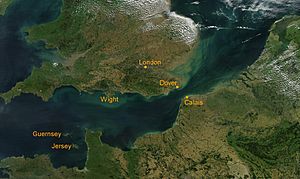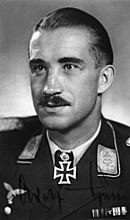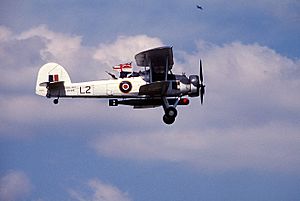Operation Donnerkeil facts for kids
Quick facts for kids Operation Donnerkeil |
|||||||
|---|---|---|---|---|---|---|---|
| Part of the Western Front of World War II | |||||||
 Satellite view of the English Channel |
|||||||
|
|||||||
| Belligerents | |||||||
| Commanders and leaders | |||||||
| Strength | |||||||
| ~450 aircraft | 252 Bf 109 and Fw 190 fighters 30 Bf 110 Heavy fighters 32 Dornier Do 217s |
||||||
| Casualties and losses | |||||||
41 aircraft |
17 fighters 5 bombers 23 airmen killed |
||||||
Operation Donnerkeil (which means Operation Thunderbolt in German) was a secret German military plan during World War II. Its main goal was to protect three large German warships as they sailed through the English Channel. This journey was called Operation Cerberus, also known as the Channel Dash.
In 1941, German warships like the battleships Scharnhorst and Gneisenau, and the cruiser Prinz Eugen, were docked in Brest, France. They had been attacking Allied ships in the Atlantic Ocean. However, the powerful Royal Navy made it too risky for them to return to German ports.
Because the ships were in Brest, they were easy targets for the Royal Air Force (RAF) bombers. The RAF attacked them many times. Adolf Hitler and the German Navy leaders wanted to move these important ships to safer ports in Germany.
So, in December 1941, the German Air Force (Luftwaffe) was ordered to plan a way to protect the ships. Adolf Galland, a top German fighter pilot, prepared the aircraft for this mission. Operation Donnerkeil and Operation Cerberus began on February 11, 1942. The Germans managed to surprise the British. The German ships reached Germany safely on February 13, 1942.
During the Channel Dash, the Luftwaffe successfully defended the German ships from British air attacks. The British suffered many losses in the air battles, while the Germans lost fewer aircraft. The operation achieved its main goal.
Contents
Why the Ships Moved
The battleships Scharnhorst and Gneisenau first arrived in Brest on March 22, 1941. They had been part of a German operation against Allied shipping. The heavy cruiser Prinz Eugen also joined them on June 1, 1941.
While in Brest, these ships were close to British airfields. The RAF attacked them often, causing some damage. From March 1941, the RAF flew nearly 3,000 missions against Brest harbor. Night bombings were safer for the British because the Germans didn't have many night-fighters.
After the German battleship Bismarck was sunk, Hitler worried about his remaining large ships. He ordered the German Navy to move them to Germany. There, they could be repaired and then sent to Norway. In Norway, they would help defend against Allied attacks.
The German Navy decided to take the shorter but more dangerous route through the English Channel.
On January 12, 1942, Hitler met with the commanders for the operation. He compared the German fleet to "a patient with cancer" who needed a risky operation to survive. The passage through the Channel was that operation. The Luftwaffe was told to provide strong air cover and create diversions.
How the Germans Prepared
The German Air Force leaders were worried about Operation Cerberus. They feared the Luftwaffe would be blamed if it failed. Despite this, Adolf Galland was given full control over the air operation, named Unternehmen Donnerkeil. The plan was so secret that Galland had to sign a special secrecy pledge.
To get enough aircraft, some training units had to be used. Most of the German fighter planes were fighting in the Soviet Union at the time.
The route through the Channel was split into three parts. To make sure the ships had constant air cover, Max Ibel, a fighter commander, was put on board Scharnhorst. He would communicate directly with the Luftwaffe units. The Germans also practiced the mission eight times, flying about 450 training flights.
The Germans also tried to block British radio signals. They used a special jamming technique that made British coastal radars less effective. German bombers also flew missions over the western Channel to trick British aircraft. Other German planes were ready to attack RAF bases in southern England.
To keep fighters constantly over the ships, mechanics had to refuel and rearm planes very quickly. Galland wanted at least 16 fighters over the ships at all times. These fighters would fly at both high and low altitudes. The low-flying planes would be harder for British radar to spot.
Galland told his pilots that protecting the ships was their most important job. They were expected to fly at least four missions on the day of the operation. Success wasn't about shooting down enemy planes, but about keeping the ships safe. If needed, pilots were even told to ram enemy aircraft.
How the British Prepared
The British had their own plan, called Operation Fuller, to stop a German breakout. The British Navy's intelligence chief, Captain Norman Dening, thought the Germans might try to use the English Channel. He warned that the German warships were getting ready to sail.
Dening told the First Sea Lord that the Channel route was shorter. He believed the Germans would rely on their destroyers and aircraft for protection. He also knew the British didn't have heavy ships in the Channel to stop them.
Air Marshal Philip Joubert de la Ferté, who led RAF Coastal Command, agreed the Channel was the likely route. He expected the Germans to try it after February 10. However, the British Air Ministry and RAF commands made a mistake. They thought the Germans would sail through the most dangerous part of the Channel at night. Because of this, most of RAF Bomber Command was told to stand down during the day. This meant they weren't ready to attack on February 12.
Coastal Command had three squadrons of Bristol Beaufort torpedo bombers ready. The Fleet Air Arm (FAA) added one squadron of Fairey Swordfish torpedo bombers. But the Beaufort squadrons were spread out and short on torpedoes. The Swordfish planes were very slow, making them hard to escort.
Aircraft Used
German Air Force (Luftwaffe)
The Luftwaffe used five main fighter wings for Operation Donnerkeil. These included Jagdgeschwader 1 (JG 1), Jagdgeschwader 2 (JG 2), and Jagdgeschwader 26 (JG 26). They mostly flew Messerschmitt Bf 109 and Focke-Wulf Fw 190 fighter planes.
The Germans had 252 fighters, 30 heavy fighters (like the Messerschmitt Bf 110), and 32 bombers (like the Dornier Do 217). The bombers were used to attack British airfields and distract the RAF.
British Air Forces (RAF and FAA)
The British relied heavily on their torpedo bombers, mainly the Beaufort and Swordfish aircraft. Three Beaufort squadrons were available, but they didn't have enough torpedoes. Many other torpedo bombers had been sent to other war zones.
No. 825 Squadron FAA used their slow Fairey Swordfish planes. Reconnaissance planes like the Lockheed Hudson were also used. RAF Bomber Command had about 242 bombers ready, but their crews were not trained to attack ships.
RAF Fighter Command sent many squadrons of Supermarine Spitfire and Hawker Hurricane fighters.
The Channel Dash Begins
First Contact
On the evening of February 10, 1942, the German ships prepared to leave Brest. RAF bombers flew overhead, but the German ships quickly turned back to the dock. The bombers dropped their bombs, but caused little damage. Luckily for the Germans, the British didn't realize the ships had tried to leave.
British intelligence had warned them, but mistakes and bad luck helped the Germans. Three British Hudson planes were on patrol. One plane, "Stopper," was watching Brest. It was attacked by a German night fighter and its radar broke. Its replacement also had radar problems.
Another plane, "Line SE," should have spotted the German fleet, but its radar failed too. The third plane, "Habo," was recalled an hour early due to mist. This meant the German ships sailed undetected for 11 hours.
By chance, a mechanic at a British radar station in Fairlight, East Sussex, picked up 27 echoes at 10:15 AM on February 12. This was the German fleet. The Germans had thought this radar station was out of action. German planes had also been jamming British radar signals.
Two experienced RAF pilots, Victor Beamish and Finlay Boyd, were sent to investigate. They flew over the Channel in Spitfires and saw many German fighters protecting a large fleet. They kept radio silence and reported their discovery after landing. It took more time for Bomber Command to be alerted.
Around 12:16 PM, the first naval battles began between German torpedo boats and British Motor Torpedo Boats. At this point, the German ships were closest to German airfields, allowing the Luftwaffe to provide maximum protection.
Main Attacks
At 12:25 PM, Lieutenant Commander Eugene Esmonde led his Swordfish planes from No. 825 Squadron FAA to attack the ships. Their fighter escorts were late or missed the meeting point. Only No. 72 Squadron Spitfires managed to find them by accident.
The slow Swordfish planes were attacked by German Fw 190 fighters. All six Swordfish were shot down. The Spitfires managed to destroy three Fw 190s in return. Some Swordfish dropped their torpedoes, but none hit the ships. Esmonde was killed and later received the Victoria Cross for his bravery.
Because Bomber Command had been told to stand down, their attacks came late in the day. They sent 73 bombers, but none hit their targets. Later, nine Beauforts from No. 42 Squadron attacked, but their torpedoes missed. Two Canadian bombers were lost without success.
Another wave of 134 to 137 bombers attacked between 4:00 PM and 5:05 PM. Only about 20 crews managed to attack due to poor training and bad visibility. Nine bombers were lost. In total, out of 242 bombers, only about 54 managed to drop bombs, and 15 were shot down.
The British did manage to damage both the Gneisenau and Scharnhorst. The Scharnhorst hit two mines, and the Gneisenau hit one mine. Both ships were able to continue sailing. It's believed these mines were dropped by British Hampden bombers.
Losses
In protecting the bombers, British Fighter Command lost 20 fighters. 14 pilots were killed and three were captured. Only eight of these fighters were shot down by the Luftwaffe. The rest were lost to anti-aircraft fire, collisions, or unknown reasons.
The Germans lost 17 fighters and five bombers. 23 German airmen were killed. German fighter units claimed to have shot down 60 RAF aircraft, but British losses were 41 aircraft in total.
After the Dash
British Problems
The British failed to work together well. The Navy, RAF, and Fleet Air Arm acted independently. There were also some friendly fire incidents. The biggest problem was Fighter Command's failure to protect the bombers and naval forces. Communication between units was poor.
RAF Bomber Command crews were not trained to attack ships. The few torpedo-bomber squadrons had supply problems. Air Marshal Philip Joubert de la Ferté blamed the failure on the lack of focus on anti-shipping aviation. He wanted all anti-shipping units to be under his command.
The Air Ministry refused his request. They continued to focus on building bombers for attacks over Germany. Many of Coastal Command's anti-shipping units were sent to the Mediterranean, leaving Britain short of these planes.
Operation Donnerkeil also showed the importance of electronic warfare. The German jamming of British radar led the British to develop new jamming techniques. This included "Window" (Chaff), which helped British bombers avoid German night fighters later in the war.
German View
Operation Donnerkeil was a big success for the Luftwaffe. They protected the ships and stopped the British air attacks. Adolf Galland called it the high point of his career.
For the German Navy, Operation Cerberus was a success in moving the ships. But it also meant they had to pull back from the Atlantic. From then on, the German U-boats fought the Battle of the Atlantic mostly alone.
The Scharnhorst and Gneisenau were damaged by mines and needed long repairs. The Prinz Eugen was torpedoed shortly after. All three ships were out of action for a long time. The Gneisenau was eventually taken out of service in February 1942. The Scharnhorst was sunk in December 1943 during the Battle of the North Cape. None of these ships sailed in the Atlantic again.
|




